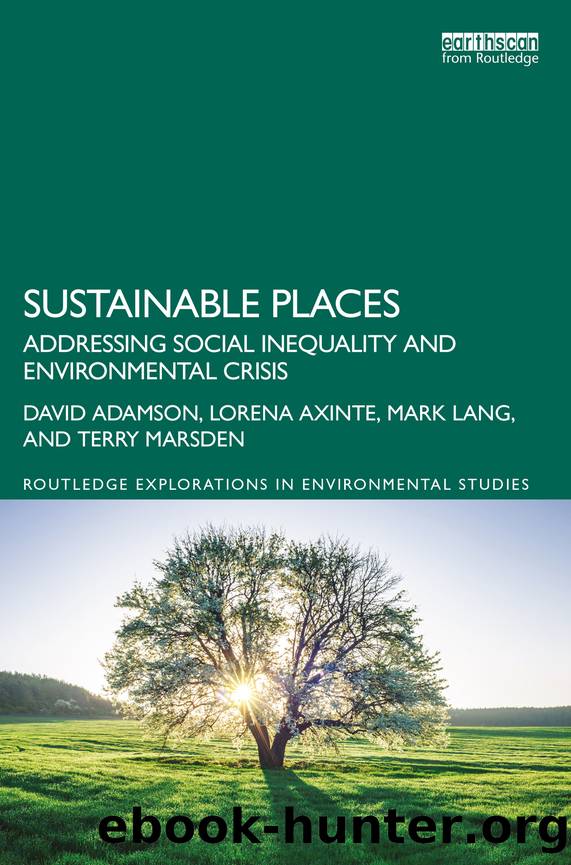Sustainable Places by unknow

Author:unknow
Language: eng
Format: epub
Publisher: Taylor & Francis (Unlimited)
Published: 2022-06-16T00:00:00+00:00
Changing our relationship(s) with food
This chapter has used the metaphor of food to discuss cultural(?) practices, norms, values, and habits, and their junctures with issues of environmental degradation, health, and inequality. Whereas many arguments refer to global phenomena, place-based examples were given wherever possible. The topics and places touched upon are by no means exhaustive, but they offer a departure point to examine and re-evaluate our relationship(s) with food. As the following paragraphs aim to conclude, this could be a first step towards changing our anthropocentric worldviews that commodify and exploit nature, depleting planetary resources at an unsustainable pace.
We have reached a point where sustainability is no longer enough. Sustaining has often translated into âdetermining how much damage can feasibly be inflictedâ (du Plessis, 2011, p. 7), and we have repeatedly failed to stay within the limits we set. As seen in the previous parts, global goals such as SDG 12 are not comprehensive enough to tackle some of our most urgent crises, like farm-level food waste. Indeed, we have been treating agriculture and âthe farm like an isolated, industrial machineâ, ignoring that the âsystem of a farm relies on interactions with the larger natural systemâ, which we cannot control (Ellen MacArthur Foundation, 2019). As a departure from this mindset, regenerative development advances from minimal or neutral environmental impact to creating positive effects for a âmutually supportive symbiosisâ between the built, cultural, and natural environments. Having degraded not only the environment but also our social and cultural systems, we need to do much more to restore and enhance ecosystems and community health (Wahl, 2017). Thus, considering the multiple crises that societies go through today, it is no longer sufficient to sustain or remain 100 percent neutral.
The regenerative paradigm was inspired by permaculture â an approach to agriculture that tries to work with nature, rather than against it, using systems thinking and nature-based solutions. Today, regenerative agriculture is gaining increasing interest from researchers and policymakers (see, for instance, IPCC, 2019), despite lacking certification (as organic agriculture does) or a commonly agreed set of practices that could protect it from greenwashing. Nonetheless, regenerative practices promise to recover soil health, capture carbon, restore degraded habitats, reduce chemical use and pesticides, and improve the overall connection with nature, and between communities. Unfortunately, this âlatent potentialâ has had limited power to transform the global food system, which is a product of its hard to transcend history (Bossio et al., 2021, p. 92), locked in an unsustainable regime. Important elements that shape our food systems materialised at a time when climate change and biodiversity loss were not a priority, and their legacy is still visible in policies, tax systems, and practices.
Nonetheless, regenerative agriculture is only one of the many initiatives that have coalesced around food. Many others have gathered enough momentum to become social movements in their own rights, demonstrating that food can be a means to reach a bigger end. Although space does not allow for a detailed summary here, it is worth mentioning Mottaâs
Download
This site does not store any files on its server. We only index and link to content provided by other sites. Please contact the content providers to delete copyright contents if any and email us, we'll remove relevant links or contents immediately.
Life 3.0: Being Human in the Age of Artificial Intelligence by Tegmark Max(5410)
The Sports Rules Book by Human Kinetics(4221)
The Age of Surveillance Capitalism by Shoshana Zuboff(4125)
ACT Math For Dummies by Zegarelli Mark(3942)
Unlabel: Selling You Without Selling Out by Marc Ecko(3561)
Blood, Sweat, and Pixels by Jason Schreier(3540)
Hidden Persuasion: 33 psychological influence techniques in advertising by Marc Andrews & Matthijs van Leeuwen & Rick van Baaren(3421)
The Pixar Touch by David A. Price(3336)
Urban Outlaw by Magnus Walker(3310)
Bad Pharma by Ben Goldacre(3213)
Project Animal Farm: An Accidental Journey into the Secret World of Farming and the Truth About Our Food by Sonia Faruqi(3145)
Kitchen confidential by Anthony Bourdain(2974)
Brotopia by Emily Chang(2953)
Slugfest by Reed Tucker(2905)
The Content Trap by Bharat Anand(2842)
The Airbnb Story by Leigh Gallagher(2757)
Coffee for One by KJ Fallon(2523)
Smuggler's Cove: Exotic Cocktails, Rum, and the Cult of Tiki by Martin Cate & Rebecca Cate(2433)
Beer is proof God loves us by Charles W. Bamforth(2348)
